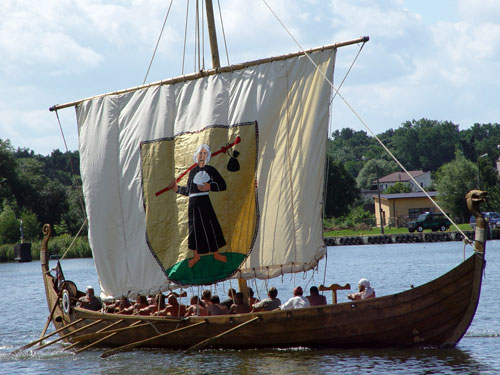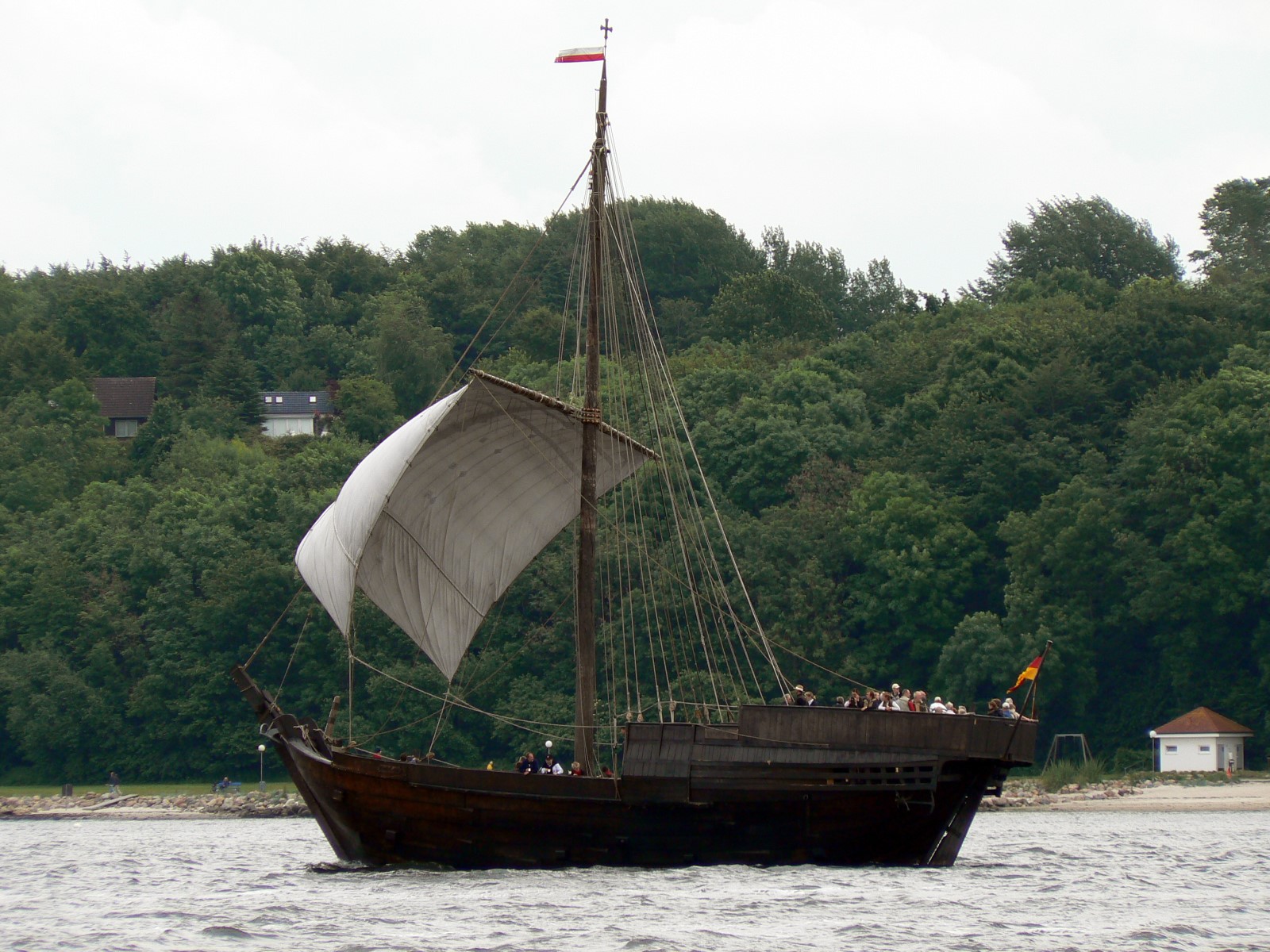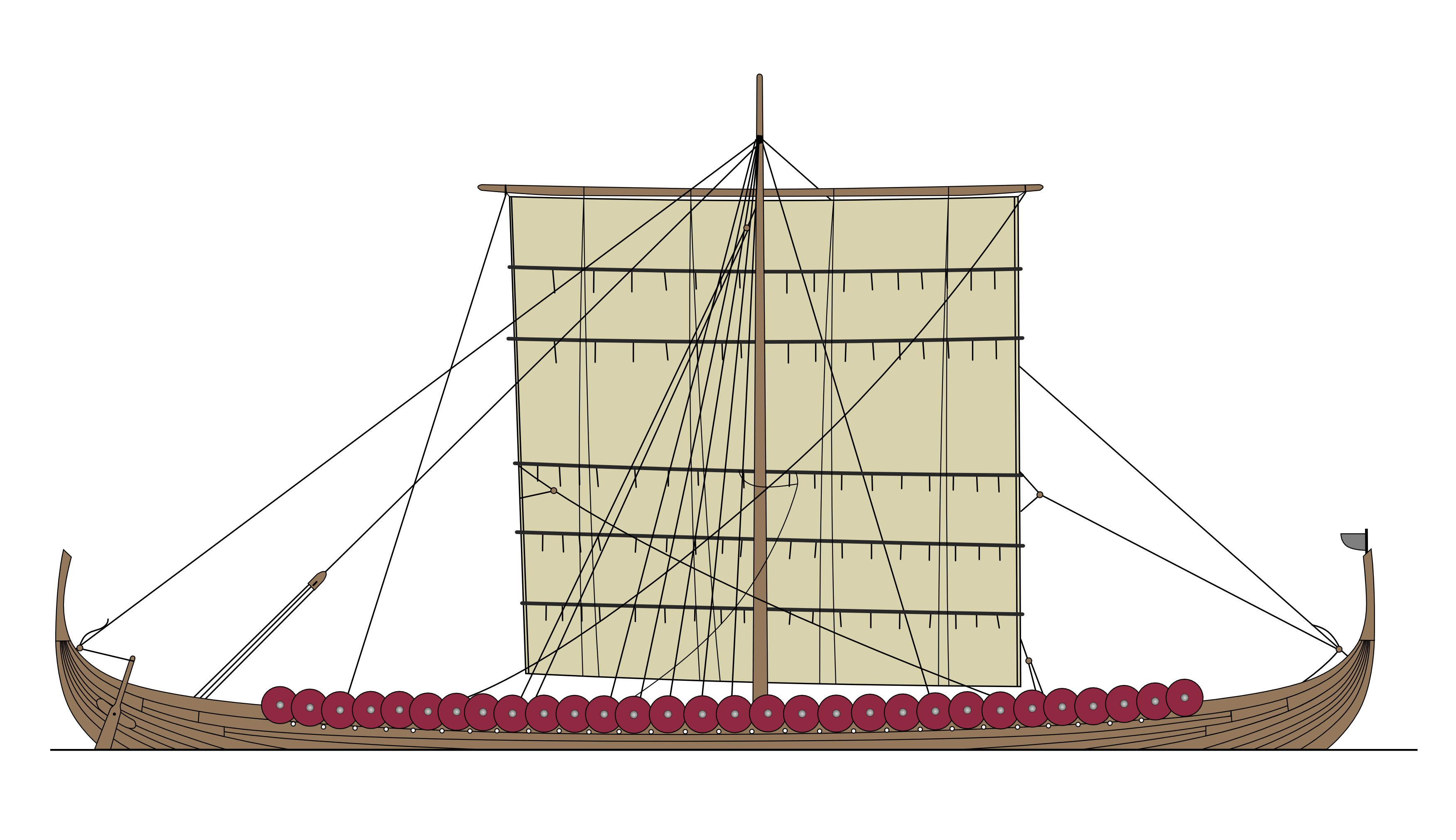|
Knarr
A knarr is a type of Norse merchant ship used by the Vikings. The knarr ( non, knǫrr, plural ) was constructed using the same clinker-built method as longships, karves, and faerings. History ''Knarr'' is the Old Norse term for a type of ship built for long sea voyages and used during the Viking expansion. The knarr was a cargo ship; the hull was wider, deeper and shorter than a longship, and could take more cargo and be operated by smaller crews. They were built with a length of about , a beam of , and a hull capable of carrying up to 24 tons. by It was primarily used to transport trading goods like walrus ... [...More Info...] [...Related Items...] OR: [Wikipedia] [Google] [Baidu] |
Viking Ships
Viking ships were marine vessels of unique structure, used in Scandinavia from the Viking Age throughout the Middle Ages. The boat-types were quite varied, depending on what the ship was intended for, but they were generally characterized as being slender and flexible boats, with symmetrical ends with true keel. They were Clinker (boat building), clinker built, which is the overlapping of planks riveted together. Some might have had a dragon's head or other circular object protruding from the bow and stern for design, although this is only inferred from historical sources. Viking ships were used both for military purposes and for long-distance trade, exploration and colonization. In the literature, Viking ships are usually seen divided into two broad categories: merchant ships and warships, the latter resembling narrow "war canoes" with less load capacity, but higher speed. However, these categories are overlapping; some transport ships would also form part of war fleets. As a ru ... [...More Info...] [...Related Items...] OR: [Wikipedia] [Google] [Baidu] |
Vikings
Vikings ; non, víkingr is the modern name given to seafaring people originally from Scandinavia (present-day Denmark, Norway and Sweden), who from the late 8th to the late 11th centuries raided, pirated, traded and settled throughout parts of Europe.Roesdahl, pp. 9–22. They also voyaged as far as the Mediterranean, North Africa, Volga Bulgaria, the Middle East, and North America. In some of the countries they raided and settled in, this period is popularly known as the Viking Age, and the term "Viking" also commonly includes the inhabitants of the Scandinavian homelands as a collective whole. The Vikings had a profound impact on the early medieval history of Scandinavia, the British Isles, France, Estonia, and Kievan Rus'. Expert sailors and navigators aboard their characteristic longships, Vikings established Norse settlements and governments in the Viking activity in the British Isles, British Isles, the Faroe Islands, Settlement of Iceland, Icela ... [...More Info...] [...Related Items...] OR: [Wikipedia] [Google] [Baidu] |
Medieval Ships
The ships of Medieval Europe were powered by sail, oar, or both. There was a large variety, mostly based on much older, conservative designs. Although wider and more frequent communications within Europe meant exposure to a variety of improvements, experimental failures were costly and rarely attempted. Ships in the north were influenced by Viking vessels, while those in the south by classical or Roman vessels. However, there was technological change. The different traditions used different construction methods; clinker in the north, carvel in the south. By the end of the period, carvel construction would come to dominate the building of large ships. The period would also see a shift from the steering oar or side rudder to the stern rudder and the development from single-masted to multi-masted ships. As the area is connected by water, people in the Mediterranean built different kinds of ships to accommodate different sea levels and climates. Within the Mediterranean area during the ... [...More Info...] [...Related Items...] OR: [Wikipedia] [Google] [Baidu] |
Ship
A ship is a large watercraft that travels the world's oceans and other sufficiently deep waterways, carrying cargo or passengers, or in support of specialized missions, such as defense, research, and fishing. Ships are generally distinguished from boats, based on size, shape, load capacity, and purpose. Ships have supported exploration, trade, warfare, migration, colonization, and science. After the 15th century, new crops that had come from and to the Americas via the European seafarers significantly contributed to world population growth. Ship transport is responsible for the largest portion of world commerce. The word ''ship'' has meant, depending on the era and the context, either just a large vessel or specifically a ship-rigged sailing ship with three or more masts, each of which is square-rigged. As of 2016, there were more than 49,000 merchant ships, totaling almost 1.8 billion dead weight tons. Of these 28% were oil tankers, 43% were bulk carriers, and ... [...More Info...] [...Related Items...] OR: [Wikipedia] [Google] [Baidu] |
Longship
Longships were a type of specialised Scandinavian warships that have a long history in Scandinavia, with their existence being archaeologically proven and documented from at least the fourth century BC. Originally invented and used by the Norsemen (commonly known as the Vikings) for commerce, exploration, and warfare during the Viking Age, many of the longship's characteristics were adopted by other cultures, like Anglo-Saxons, and continued to influence shipbuilding for centuries. The longship's design evolved over many centuries, and continuing up until the sixth century with clinker-built ships like Nydam. The longship appeared in its complete form between the ninth and 13th centuries. The character and appearance of these ships have been reflected in Scandinavian boatbuilding traditions to the present day. The particular skills and methods employed in making longships are still used worldwide, often with modern adaptations. They were all made out of wood, with cloth sails ... [...More Info...] [...Related Items...] OR: [Wikipedia] [Google] [Baidu] |
Karve (ship)
Karves (or Karvi) were a small type of longship with broad hull, somewhat similar to the ocean-going knarr cargo ships. Karves were used for both war and ordinary transport, carrying people, goods or livestock. Because they were able to navigate in very shallow water, they were also used for coasting. Karves had broad beams of approximately , were up to in length, and allowed for up to 16 oars. The Tune ship The Tune ship (''Tuneskipet'') is a Viking ship exhibited in the Viking Ship Museum (''Vikingskipshuset på Bygdøy'') in Bygdøy, Oslo. The Tune ship is of the karve, a small type of longship with broad hull. It was found at the Haugen far ... from Norway is an example of a historical Karve ship. Notes Viking ships Merchant sailing ship types Naval sailing ship types {{ship-type-stub ... [...More Info...] [...Related Items...] OR: [Wikipedia] [Google] [Baidu] |
Skuldelev Ships
The Skuldelev ships are five original Viking ships recovered from the waterway of Peberrenden at Skuldelev, north of Roskilde in Denmark. In 1962, the remains of the submerged ships were excavated in the course of four months. The recovered pieces constitute five types of Viking ships and have all been dated to the 11th century. They are thought to have been sunk to prevent attacks from the sea. When the remains were unearthed, they were thought to comprise six ships, but "Skuldelev 2" and "Skuldelev 4" were later discovered to be parts of one ship. Together, the five Skuldelev ships provide a good source of information about the shipbuilding traditions of the late Viking Age and are now exhibited at the Viking Ship Museum in Roskilde. The museum has built accurate reconstructions of all five of the original Skuldelev ships; some of them have also been reconstructed by other groups across the world. Skuldelev 1 Skuldelev 1 was a sturdy seagoing cargo-vessel, possibly of the kn ... [...More Info...] [...Related Items...] OR: [Wikipedia] [Google] [Baidu] |
Modell Knorr
Modell is the German word for "model" and also a surname. It may refer to: People * Arnold Modell (1924–2022), American professor of social psychiatry * Art Modell (1925–2012), American business executive and sports team owner * Bernadette Modell, (born 1935), British geneticist * David Modell (1961–2017), American business executive and sports team owner * Frank Modell (1917-2016), American cartoonist * Merriam Modell (1908–1994), American author of pulp fiction * Pat Modell (1931–2011), American TV actress * Rod Modell, given name for Deepchord, electronic music producer from Detroit, Michigan * William Modell (1921–2008), American businessman and chairman of Modell's Sporting Goods Companies * Modell's, a sporting goods retailer based in New York City * Modell (pawn shop), a pawnbroker based in New York City, originally formed as a spinoff of the sporting goods company * Schabak Modell, a die-cast toy producer in Germany * Schuco Modell, a die-cast toy produc ... [...More Info...] [...Related Items...] OR: [Wikipedia] [Google] [Baidu] |
Vinland
Vinland, Vineland, or Winland ( non, Vínland ᚠᛁᚾᛚᛅᚾᛏ) was an area of coastal North America explored by Vikings. Leif Erikson landed there around 1000 AD, nearly five centuries before the voyages of Christopher Columbus and John Cabot. The name appears in the Vinland Sagas, and describes Newfoundland and the Gulf of Saint Lawrence as far as northeastern New Brunswick. Much of the geographical content of the sagas corresponds to present-day knowledge of transatlantic travel and North America. In 1960, archaeological evidence of the only known Norse site in North America, L'Anse aux Meadows, was found on the northern tip of the island of Newfoundland. Before the discovery of archaeological evidence, Vinland was known only from the sagas and medieval historiography. The 1960 discovery further proved the pre-Columbian Norse exploration of mainland North America. L'Anse aux Meadows has been hypothesized to be the camp '' Straumfjörð'' mentioned in the ''Saga of Eri ... [...More Info...] [...Related Items...] OR: [Wikipedia] [Google] [Baidu] |
Roskilde
Roskilde ( , ) is a city west of Copenhagen on the Danish island of Zealand. With a population of 51,916 (), the city is a business and educational centre for the region and the 10th largest city in Denmark. It is governed by the administrative council of Roskilde Municipality. Roskilde has a long history, dating from the pre-Christian Viking Age. Its UNESCO-listed Gothic cathedral, now housing 39 tombs of the Danish monarchs, was completed in 1275, becoming a focus of religious influence until the Reformation. With the development of the rail network in the 19th century, Roskilde became an important hub for traffic with Copenhagen, and by the end of the century, there were tobacco factories, iron foundries and machine shops. Among the largest private sector employers today are the IT firm BEC (Bankernes EDB Central) and seed company DLF. The Risø research facility is also becoming a major employer, extending interest in sustainable energy to the clean technology sphere. The ... [...More Info...] [...Related Items...] OR: [Wikipedia] [Google] [Baidu] |
Viking Ship Museum (Roskilde)
The Viking Ship Museum ( da, Vikingeskibsmuseet) in Roskilde is Denmark's national ship museum for ships of the Prehistory, prehistoric and Middle Ages, medieval period. The main focus of the museum is a permanent exhibition of the Skuldelev ships, five original Viking ships excavated nearby in 1962. The Viking Ship Museum also conducts research and educates researchers in the fields of maritime history, Maritime archaeology, marine archaeology and experimental archaeology. Various academic conferences are held here and there is a research library in association with the museum. Original Viking ships Around the year 1070, five Viking ships were blockship, deliberately sunk at Skuldelev in Roskilde Fjord in order to block the most important fairway and to protect Roskilde from an enemy attack from the sea. These ships, later known as the Skuldelev ships, were excavated in 1962. They turned out to be five different types of ships ranging from cargo ships to ships of war. The Vi ... [...More Info...] [...Related Items...] OR: [Wikipedia] [Google] [Baidu] |
Roskilde Fjord
Roskilde Fjord is the fjord north of Roskilde, Denmark. It is a long branch of the Isefjord. Cities The cities Frederiksværk, Frederikssund, Jægerspris, Jyllinge and Roskilde (including Himmelev), (home to the famous Roskilde Festival), all have coastline at Roskilde Fjord. The image on this page shows the view of the fjord, as seen from Roskilde. Viking Time During the Viking time around 1000 AD the people of Roskilde decided to sink a number of their ships in the fjord at Skuldelev in order to prevent the Vikings from coming in and raiding. Originally five were discovered; but while extending the museum that houses these finds another nine were uncovered. See also * Roskilde Roklub Roskilde Roklub (English: Roskilde Rowing Club) is a rowing club based in Roskilde, Denmark. Its home water is Roskilde Fjord. History The club was founded in 1890. International performances Carl-Ebbe Andersen, Tage Henriksen, and Finn Peder ... References Fjords of Denmark Ge ... [...More Info...] [...Related Items...] OR: [Wikipedia] [Google] [Baidu] |





.jpg)



